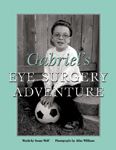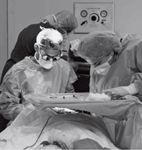Article
Book helps kids prepare for eye surgery
As a pediatric ophthalmologist, Mark Silverberg, MD, relies on special tactics and tools to make his young patients feel at ease. Dr. Silverberg is pleased to have a new book to share with kids and their families that tells the story of eye surgery from a child's perspective, in simple terms with illustrative photographs.
As a pediatric ophthalmologist, Mark Silverberg, MD, relies on special tactics and tools to make his young patients feel at ease. Dr. Silverberg is pleased to have a new book to share with kids and their families that tells the story of eye surgery from a child's perspective, in simple terms with illustrative photographs.

"The original book was wonderful," Dr. Silverberg said. "It was well-received and used by pediatric ophthalmologists."

Things have changed
The most significant change is that, in the original story, the boy had to spend a night in the hospital; today, strabismus surgery is an outpatient procedure.
The process of updating the book began with choosing the child that would portray Gabriel.

After the photos were ready, they were laid out on a large table and Dr. Silverberg and the book's author, Susan Wolf, began to add text.
"The project took a year to complete," Dr. Silverberg said. "It was a challenge to be specific and detailed about the process, but generic enough for all ophthalmologists to use in their practice. I tried not to impose too much of my personal practice."
The story begins with Gabriel visiting his eye doctor (Dr. Mark) for an examination. He wears a patch to get ready for surgery. Gabriel explains how he feels before surgery, what happens before he goes to sleep, and how his eyes felt when he woke up. And, the happy ending for Gabriel is having "straight" eyes.
"Kids have a fear of the unknown and of being taken away from their parents," Dr. Silverberg explained. "This book details the little things that happen and takes some of the mystery away. Even parents are finding it beneficial; the book alleviates their anxiety, too.
"It's all framed in a positive way," he added. "It's an adventure, not a trip to the hospital. Framing the story this way and using positive words makes it so effective."
The book was published by the Sansum Clinic in Santa Barbara and was funded by the Bialis Family Foundation. Five thousand copies were printed-half in English and half in Spanish. Dr. Silverberg has been distributing books to his patients and will share it at upcoming meetings, including the AAPOS meeting. He also has been responding to requests for copies via the Internet and has sent books around the world.





